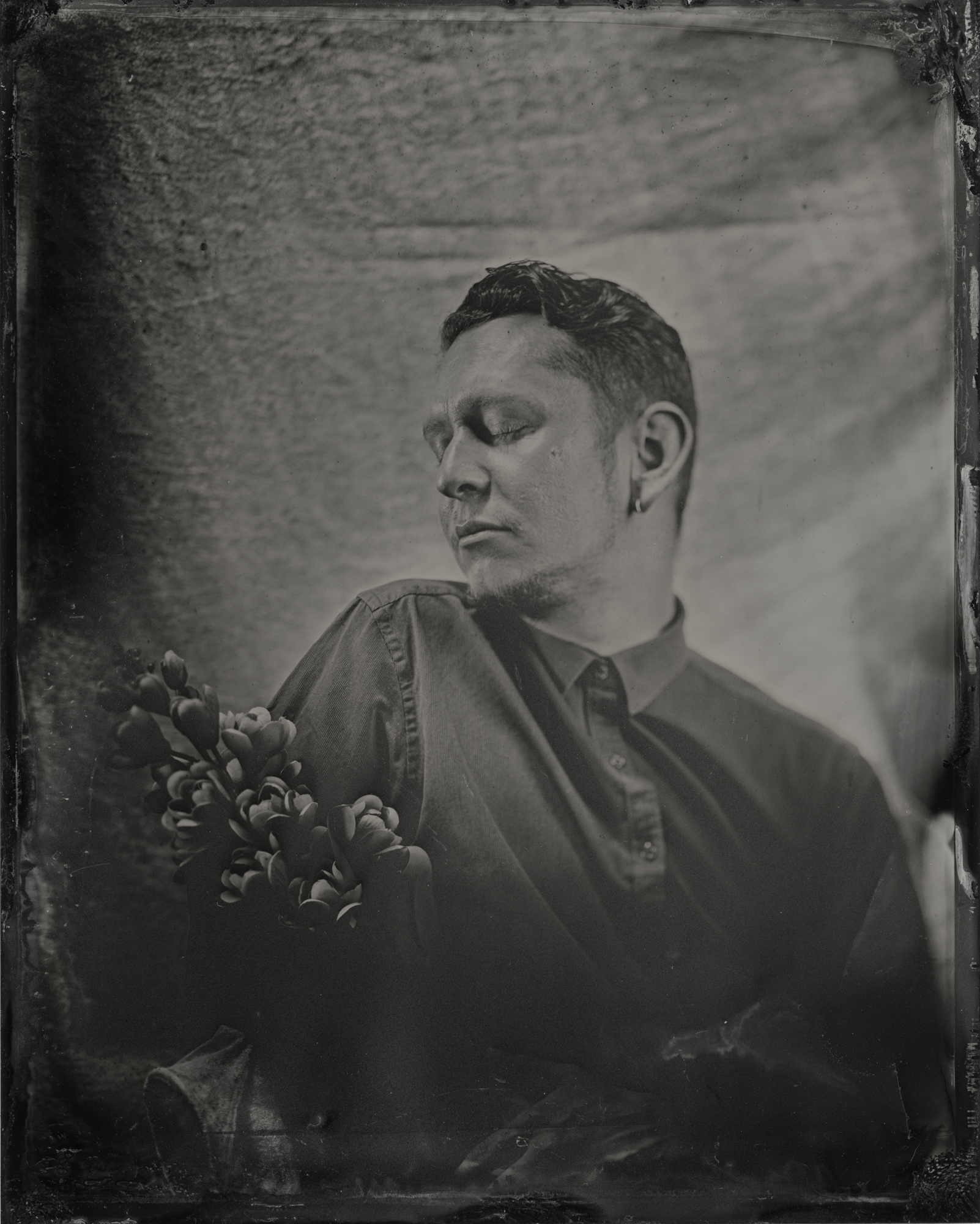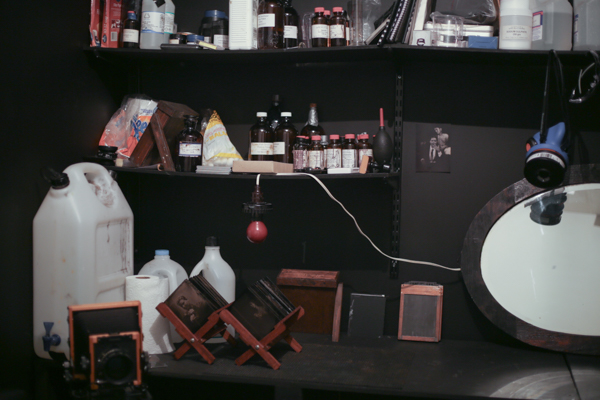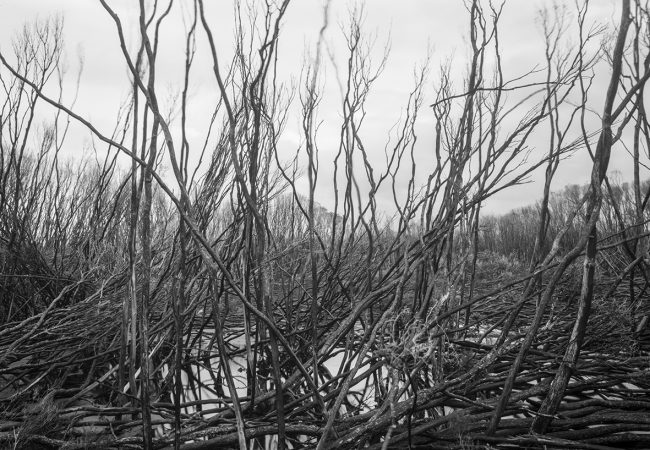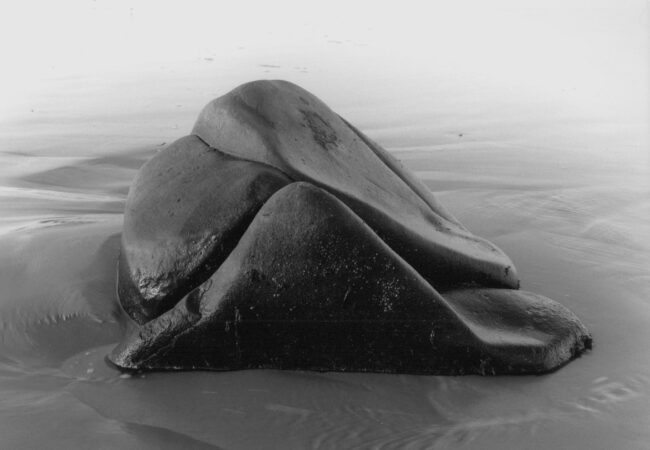Nelson Trees - Silver gelatin print I am a photographer/educator…

The Photograph Considered number seventeen – Sophie Caligari
Portrait of Fabián Barraza. Wet plate collodion
The choice to photograph using the wet plate collodion process isn’t a conscious one anymore. In 2015 I began capturing 4 x 5 tintypes and have found it to be the most engaging and novel process to date. It’s a format that knows when you’re frustrated, can sense when you’re angry and is unresponsive if you’re not entirely present. Large format takes on a whole new life when capturing plates; two dimensions become three and the ephemeral almost tangible. Chemically I know this is because silver clusters form on the surface of the plate and create physical mounds in highlights and valleys in the shadows. However, in my experience the collodion process makes space for some of the most honest captures. Perhaps it’s more difficult to keep up a façade in front of a lens for 40+minute sessions, or maybe it’s the historical knowledge that this process from 1850 existed before racial bias in film developing as well as widespread visual homophobia; both aspects of image making history that have deeply and insidiously influenced how we perceive the past. I’m yet to pinpoint what it is about the process and my practice that creates this sort of open space for private expression, but it’s what keeps me in the darkroom.
The image above was shot in collaboration with image-maker, artist and dear friend Joel Birnie. This session was the first time I have hosted Joel in my darkroom and been able to give him a full demonstration of the collodion process. Usually a digital still and moving image-maker with an interest in roll film, this was the first opportunity we’ve had for Joel to apply his eye to the process and the results were even dreamier than I anticipated. This image was actually a test shot we had his partner, performance artist Fabián Barraza sit for before I relinquished control of my camera and sat for a portrait myself (a rarity).
What I love most about this capture is the sense of ease. Taken on a day we were all low on energy, there’s an almost palpable sense of vulnerability and trust between Fabián and us as the photographers. These tender captures are accessible when working commercially with strangers, but take on a whole other level when working with those close to you and those with whom you find communication the easiest. With Joel and Fabián it has never been difficult, we share so many sources of inspiration and interest, particularly 19thCentury horror stories, 1920s aesthetics and considered lighting design. This all translates to the darkroom as well. What is usually a rehearsed speech and demonstration becomes a very relaxed presentation of the process, making it easier to be present with the act of pouring chemicals and physically making an image.
When running these informal sessions I like to start with a 150mm lens, as it allows for the headroom reminiscent of 19thCentury portraits, placing the subject in the centre of the frame. While waiting for us to set up, Fabián came across an image of Hans Christen Anderson holding a bouquet which then became the reference for our test shot. All images taken during this session were made onto sheets of aluminum coated with black acrylic known as a tintype or less commonly an aluminotype or melainotype. Though I’d rather work with black glass (ambrotype), there’s a charm that comes with shooting on tin that I adore; sort of like an antique Polaroid the plates are both an underexposed negative and a ‘print’ in one, being developed immediately after leaving the camera.

To reach the final stage, after being transformed into a light-sensitive surface – using a combination of the collodion emulsifier and silver nitrate – the plate then has to pass nine further steps, clear seven baths including developer, fix and sodium sulphite before being varnished and cured. Though I was taking on the task of the physical process, framing and lighting design were worked on by both Joel and myself and just as we went to hit the shutter, the sun came blasting through the corrugated plastic roofing, giving Fabián his angelic appearance as well as aiding our exposure time considerably as the process has an excruciating ISO of 1.
It seems fitting to me that even in the spur of the moment, we as queer folk drew inspiration from Hans Christen Anderson, a man rumored to be bisexual and deliberately celibate during his life. This shared element of our respective identities is an ongoing and influencing factor in the images we create as well as our daily lives. A sometimes coded, yet ever-present form of communication we engage with as those who identify outside the norm. After 400+ tintypes in the space of a few years, I have learned that the most valuable story of the individual can be found outside the verbal and cranial spheres. The essence of ourselves that is projected out into the ether for others to feel and connect to is what I’m seeking to capture and is something that seems almost material when shared in kinship and with those you can identify with; a silent language of safety and mutual understanding.
Although not originally intended to be a part of any series, this capture speaks to a larger theme within my practice. To use this kind of portraiture to record the subtle and unconscious ways in which we visually transmit our inner workings as well as to explore how our bodies serve as our primary forms of communication, not only with people but with the world at large. I endeavor to understand what can be revealed when this is the goal of a capture. Explorations on this concept and camp forms of communication are themes I will be exploring in early 2019 for a show curated by Dr Alison Bennett and Dr Ray Cook titled Widgets and Doohickies from a Camp Toolbox, on display in January 2019 at the RMIT Spare Room Gallery.
You can follow my projects on Instagram @sophiecaligariphotography as well as my art history podcast @arttoartpodcast where we unpack a comprehensive and unbiased history of the art world.
Joel Birnie can be found at www.joelstephenbirnie.comor on Instagram @houseofhaborym (personal) and @blixpoxandblunder (films/commercial). Fabián Barraza can be found @wolfsbayn.
 Sophie Caligari with 4×5 camera
Sophie Caligari with 4×5 camera
Australian photographer and printmaker Sophie Caligari’s works explore themes of antiquity, memory, historical context, the body as communication and photographic theory. Known mostly for her wet plate collodion practice, Sophie’s use of meticulous composition and intentional, considered lighting design gives her subjects the governing voice in her work. Predominately exploring human and botanical subjects, Sophie’s work evokes ideas of camp expression, nostalgia and vulnerability while transporting the viewer to a place often described as ‘enigmatic and present yet wistful and sentimental’.
Previous Post: SP-8×10+: A daylight 8×10 sheet film developing tank



